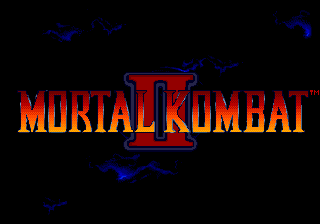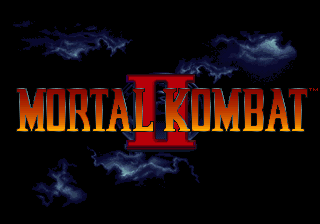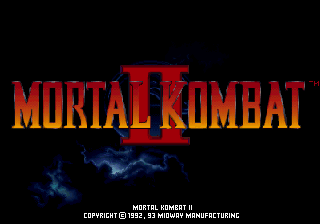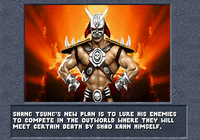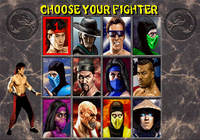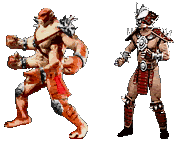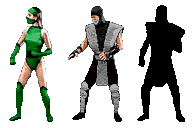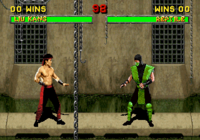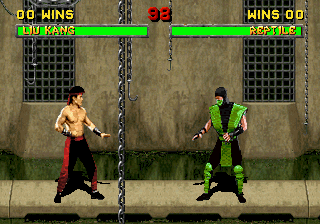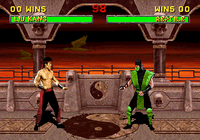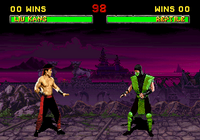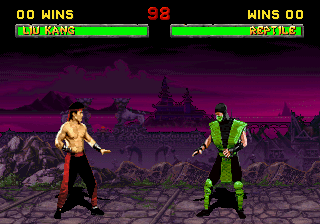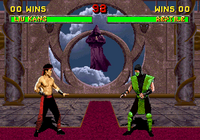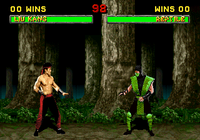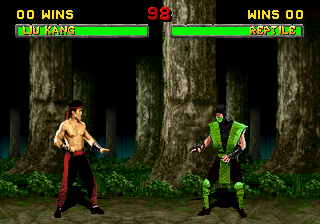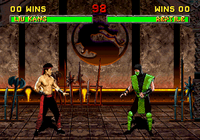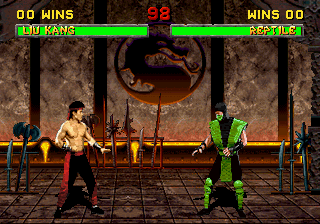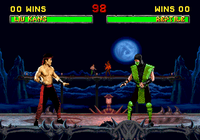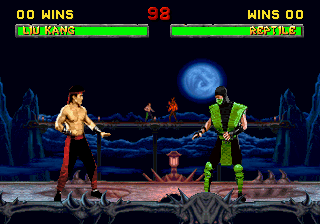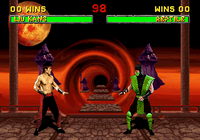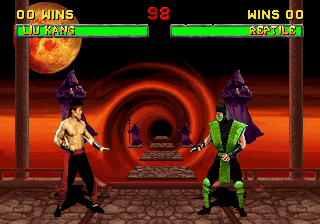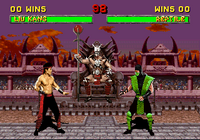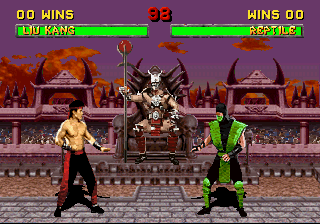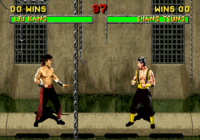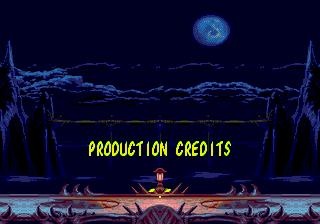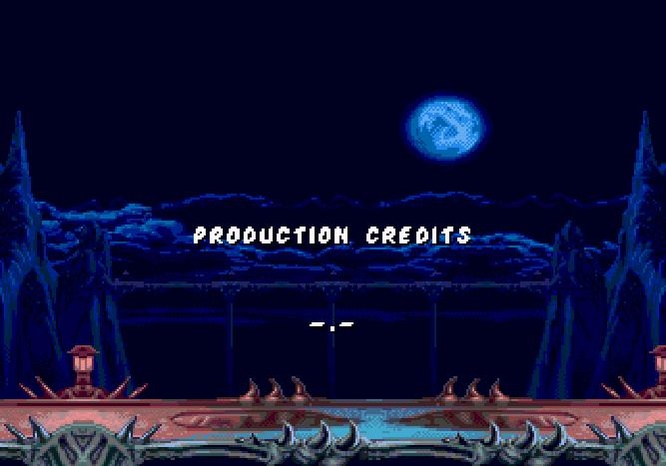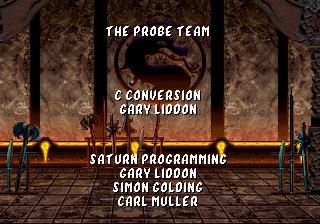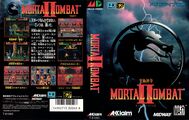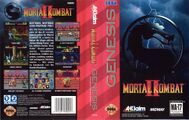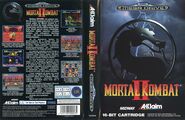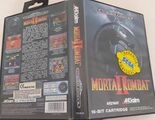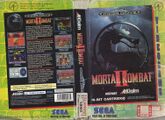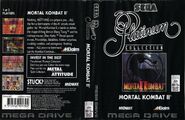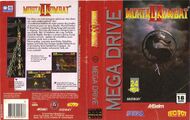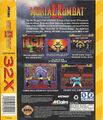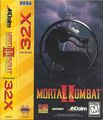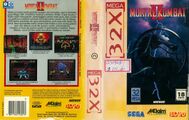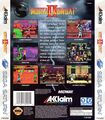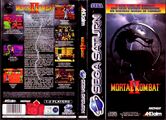Difference between revisions of "Mortal Kombat II"
From Sega Retro
(→Characters: MoveListNote template) |
m (Text replacement - "| region=SE rental (SF)" to "| region=SE (rental; SF)") |
||
| (10 intermediate revisions by 3 users not shown) | |||
| Line 1: | Line 1: | ||
| + | {{OtherPage|desc=the [[Sega Master System]] and [[Sega Game Gear]] game|page=Mortal Kombat II (8-bit)}} | ||
{{Bob | {{Bob | ||
| bobscreen=MKIIGen1.png | | bobscreen=MKIIGen1.png | ||
| bobscreen2=MK2 Title.png | | bobscreen2=MK2 Title.png | ||
| bobscreen3=MK2Saturn Title.PNG | | bobscreen3=MK2Saturn Title.PNG | ||
| − | |||
| − | |||
| tab1=Mega Drive | | tab1=Mega Drive | ||
| tab2=32X | | tab2=32X | ||
| tab3=Saturn | | tab3=Saturn | ||
| − | + | | publisher=[[Acclaim Entertainment]], {{company|[[Acclaim Japan]]|region=JP}} | |
| − | + | | developer={{company|[[Probe Software]]|system=MD}} | |
| − | | publisher=[[Acclaim Entertainment]] | ||
| − | {{company|[[Acclaim Japan]] | ||
| − | | developer={{company|[[Probe Software]]|system=MD | ||
{{company|[[Probe Entertainment]]|system=32X,SAT}} | {{company|[[Probe Entertainment]]|system=32X,SAT}} | ||
| − | {{company|[[The Gray Team]]|system=MD,32X | + | {{company|[[The Gray Team]]|system=MD,32X}} |
{{company|[[Red Team]]|system=SAT}} | {{company|[[Red Team]]|system=SAT}} | ||
| − | | distributor={{company|[[SF Interactive Media]]|system=MD|region=SE rental}} | + | | distributor={{company|[[Ecofilmes]]|region=PT|system=MD,SAT}} |
| + | {{company|[[SF Interactive Media]]|system=MD|region=SE rental}} | ||
| + | {{company|[[Sega-Ozisoft]]|system=MD|region=AU}} | ||
| + | {{company|[[Tec Toy]]|system=MD,32X|region=BR}} | ||
| licensor=[[Midway Manufacturing]] | | licensor=[[Midway Manufacturing]] | ||
| − | | system=[[Sega Mega Drive]], [[Sega 32X | + | | system=[[Sega Mega Drive]], [[Sega 32X]], [[Sega Saturn]] |
| sounddriver={{MD}} {{32X}} [[Krisalis sound driver]] {{SAT}} SCSP (1 track) | | sounddriver={{MD}} {{32X}} [[Krisalis sound driver]] {{SAT}} SCSP (1 track) | ||
| − | | peripherals={{MD}} [[Mega Net 2]] {{MD}} {{32X}} [[Six Button Control Pad (Mega Drive)|Six Button Control Pad | + | | peripherals={{MD}} [[Mega Net 2]] {{MD}} {{32X}} [[Six Button Control Pad (Mega Drive)|Six Button Control Pad]] |
| players=1-2 | | players=1-2 | ||
| − | | genre=Fighting Action/Kakutou Action (格闘アクション){{fileref|MK2 32X JP Box Front.jpg}}, Action/Fighting{{fileref|MK2 MD SE Box rental.jpg}}, Action{{fileref|MK2 MD JP Box.jpg}}{{ref|https://web.archive.org/web/20200702232146/https://sega.jp/history/hard/megadrive/software_l.html}}{{ref|https://web.archive.org/web/20200320230509/https://sega.jp/fb/segahard/ss/soft_licensee2.html}}{{ref|https://web.archive.org/web/20130619133127/http://sega.jp/fb/segahard/32x/soft.html | + | | genre=Fighting Action/Kakutou Action (格闘アクション){{fileref|MK2 32X JP Box Front.jpg}}, Action/Fighting{{fileref|MK2 MD SE Box rental.jpg}}, Action{{fileref|MK2 MD JP Box.jpg}}{{ref|https://web.archive.org/web/20200702232146/https://sega.jp/history/hard/megadrive/software_l.html}}{{ref|https://web.archive.org/web/20200320230509/https://sega.jp/fb/segahard/ss/soft_licensee2.html}}{{ref|https://web.archive.org/web/20130619133127/http://sega.jp/fb/segahard/32x/soft.html}}{{fileref|MK2 Saturn JP Box Back.jpg}} |
| − | |||
| originalsystem=Arcade boards | | originalsystem=Arcade boards | ||
| releases={{releasesMD | | releases={{releasesMD | ||
| Line 50: | Line 48: | ||
| md_rating_au_spc=ma15 | | md_rating_au_spc=ma15 | ||
| md_date_pt=199x | | md_date_pt=199x | ||
| − | | md_code_pt= | + | | md_code_pt=MD81346 |
| md_date_gr=199x | | md_date_gr=199x | ||
| md_code_gr=T-81346-50 | | md_code_gr=T-81346-50 | ||
| md_rating_gr=15 | | md_rating_gr=15 | ||
| md_date_se_r=199x | | md_date_se_r=199x | ||
| + | | md_date_za=199x | ||
}} | }} | ||
{{releasesSat | {{releasesSat | ||
| Line 78: | Line 77: | ||
| sat_date_pt=199x | | sat_date_pt=199x | ||
| sat_code_pt= | | sat_code_pt= | ||
| − | |||
| − | |||
| − | |||
| − | |||
| − | |||
| − | |||
| − | |||
| − | |||
| − | |||
| − | |||
| − | |||
| − | |||
| − | |||
| − | |||
| − | |||
| − | |||
| − | |||
| − | |||
| − | |||
| − | |||
| − | |||
| − | |||
| − | |||
| − | |||
| − | |||
| − | |||
| − | |||
| − | |||
| − | |||
| − | |||
| − | |||
| − | |||
| − | |||
| − | |||
| − | |||
| − | |||
| − | |||
| − | |||
| − | |||
}} | }} | ||
{{releases32X | {{releases32X | ||
| Line 143: | Line 103: | ||
| 32x_code_au=FMOR01SXC | | 32x_code_au=FMOR01SXC | ||
}} | }} | ||
| − | | otherformats={{NonSega|Arcade|SNES | + | | otherformats={{NonSega|Arcade|SNES|Amiga|IBMPC|PS}} |
}} | }} | ||
'''''{{PAGENAME}}''''', called '''''Mortal Kombat II: Kyuukyoku Shinken''''' (モータルコンバットII 究極神拳) in Japan, is the sequel to the critically acclaimed ''[[Mortal Kombat]]''. It was originally released in 1993 as an arcade game before being ported to numerous platforms. It is considered by many to be the best fighter of the series. It sports a cast of twelve characters with numerous special moves including new finishers and new kinds of finishers. | '''''{{PAGENAME}}''''', called '''''Mortal Kombat II: Kyuukyoku Shinken''''' (モータルコンバットII 究極神拳) in Japan, is the sequel to the critically acclaimed ''[[Mortal Kombat]]''. It was originally released in 1993 as an arcade game before being ported to numerous platforms. It is considered by many to be the best fighter of the series. It sports a cast of twelve characters with numerous special moves including new finishers and new kinds of finishers. | ||
| Line 156: | Line 116: | ||
==Gameplay== | ==Gameplay== | ||
| − | |||
{{ScreenThumb|MK2Saturn Charselect.PNG|width=200|Choose Your Fighter}} | {{ScreenThumb|MK2Saturn Charselect.PNG|width=200|Choose Your Fighter}} | ||
The game plays almost identically to ''[[Mortal Kombat]]'', with numerous improvements. There are several changes in standard moves: a crouching punch was added, low and high kicks have greater differentiation, roundhouse kicks are made more powerful (now knocking opponents across the screen, like the uppercut), and it is easier to perform combos due to reduced recovery times for attacks. Returning characters also gained new special moves, including some to be used in midair, and the game plays almost twice as fast as the original. The game is completely uncensored from the start, so no code is needed to uncensor the game. | The game plays almost identically to ''[[Mortal Kombat]]'', with numerous improvements. There are several changes in standard moves: a crouching punch was added, low and high kicks have greater differentiation, roundhouse kicks are made more powerful (now knocking opponents across the screen, like the uppercut), and it is easier to perform combos due to reduced recovery times for attacks. Returning characters also gained new special moves, including some to be used in midair, and the game plays almost twice as fast as the original. The game is completely uncensored from the start, so no code is needed to uncensor the game. | ||
| Line 170: | Line 129: | ||
Fatalities are performed as in the original game, and each character now has two of each, in addition to three stage-specific Fatalities. Non-lethal finishing moves have also been added: Babalities (which transforms the loser into an infant) and Friendships (a non-malicious interaction, such as dancing or giving a gift to the defeated opponent). These were put into the original arcade version of the game to poke fun at those who felt the original ''Mortal Kombat'' was too violent. | Fatalities are performed as in the original game, and each character now has two of each, in addition to three stage-specific Fatalities. Non-lethal finishing moves have also been added: Babalities (which transforms the loser into an infant) and Friendships (a non-malicious interaction, such as dancing or giving a gift to the defeated opponent). These were put into the original arcade version of the game to poke fun at those who felt the original ''Mortal Kombat'' was too violent. | ||
| − | + | ===Characters=== | |
{{MoveListNote|legend=MortalKombat}} | {{MoveListNote|legend=MortalKombat}} | ||
All characters can perform roundhouse kicks with {{left}}+{{HighKick}} (which knock the opponent across the screen), leg sweeps with {{left}}+{{LowKick}} (which cause the opponent to fall down), and uppercuts with {{down}}+{{HighPunch}} (which knock the opponent high into the air). Throws are performed by pressing {{LowPunch}} when next to the opponent. | All characters can perform roundhouse kicks with {{left}}+{{HighKick}} (which knock the opponent across the screen), leg sweeps with {{left}}+{{LowKick}} (which cause the opponent to fall down), and uppercuts with {{down}}+{{HighPunch}} (which knock the opponent high into the air). Throws are performed by pressing {{LowPunch}} when next to the opponent. | ||
| Line 182: | Line 141: | ||
The Saturn version of the game has an option to change the ninja slide ability, shared by Reptile and Sub-Zero, from {{left}}+{{Block}}+{{LowPunch}}+{{LowKick}} (same as the arcade version) to {{left}}+{{LowKick}}+{{HighKick}} (same as the Mega Drive and 32X versions). | The Saturn version of the game has an option to change the ninja slide ability, shared by Reptile and Sub-Zero, from {{left}}+{{Block}}+{{LowPunch}}+{{LowKick}} (same as the arcade version) to {{left}}+{{LowKick}}+{{HighKick}} (same as the Mega Drive and 32X versions). | ||
| − | + | ====Playable==== | |
Liu Kang, Johnny Cage, Sub-Zero, Scorpion, Reptile, Rayden, and Shang Tsung return from the original game (with Reptile and Shang Tsung now playable). Sonya and Kano are the only playable characters from the first game who do not return as playable characters, appearing only in the background of the Kahn's Arena stage, chained and on display as his prisoners. | Liu Kang, Johnny Cage, Sub-Zero, Scorpion, Reptile, Rayden, and Shang Tsung return from the original game (with Reptile and Shang Tsung now playable). Sonya and Kano are the only playable characters from the first game who do not return as playable characters, appearing only in the background of the Kahn's Arena stage, chained and on display as his prisoners. | ||
| Line 421: | Line 380: | ||
}} | }} | ||
| − | + | ====Bosses==== | |
Finishing moves cannot be performed by or against the boss or secret characters. | Finishing moves cannot be performed by or against the boss or secret characters. | ||
{{InfoTable| | {{InfoTable| | ||
| Line 436: | Line 395: | ||
}} | }} | ||
| − | + | ====Hidden==== | |
{{mainArticle|{{PAGENAME}}/Hidden content}} | {{mainArticle|{{PAGENAME}}/Hidden content}} | ||
{{InfoTable| | {{InfoTable| | ||
| Line 456: | Line 415: | ||
}} | }} | ||
| − | + | ===Stages=== | |
{{mainArticle|{{PAGENAME}}/Comparisons}} | {{mainArticle|{{PAGENAME}}/Comparisons}} | ||
The stages are played in order (and loop around after the last one), with the exception of the Kahn's Arena stage, which is solely used for the boss fights with Kintaro and Shao Kahn. The Dead Pool, Kombat Tomb, and Pit II stages have stage-specific Fatalities. | The stages are played in order (and loop around after the last one), with the exception of the Kahn's Arena stage, which is solely used for the boss fights with Kintaro and Shao Kahn. The Dead Pool, Kombat Tomb, and Pit II stages have stage-specific Fatalities. | ||
| Line 471: | Line 430: | ||
{{gitem|MK2 Saturn ThePortal.png|The Portal}} | {{gitem|MK2 Saturn ThePortal.png|The Portal}} | ||
{{gitem|MK2 Saturn KahnsArena.png|Kahn's Arena}} | {{gitem|MK2 Saturn KahnsArena.png|Kahn's Arena}} | ||
| − | |||
| − | |||
| − | |||
| − | |||
| − | |||
| − | |||
| − | |||
| − | |||
| − | |||
| − | |||
| − | |||
| − | |||
| − | |||
| − | |||
| − | |||
| − | |||
| − | |||
| − | |||
| − | |||
| − | |||
| − | |||
| − | |||
| − | |||
| − | |||
| − | |||
| − | |||
| − | |||
| − | |||
| − | |||
| − | |||
}} | }} | ||
| Line 519: | Line 448: | ||
The port received many lukewarm reviews due to its inferior soundtrack, but is preferred by some over the [[Super NES]] version for its tight controls. | The port received many lukewarm reviews due to its inferior soundtrack, but is preferred by some over the [[Super NES]] version for its tight controls. | ||
| − | |||
| − | |||
| − | |||
| − | |||
| − | |||
===Saturn version=== | ===Saturn version=== | ||
| Line 586: | Line 510: | ||
| pdf=Mortal Kombat II 32X credits.pdf | | pdf=Mortal Kombat II 32X credits.pdf | ||
| console=32X | | console=32X | ||
| − | |||
| − | |||
| − | |||
| − | |||
| − | |||
| − | |||
| − | |||
| − | |||
| − | |||
| − | |||
| − | |||
| − | |||
| − | |||
| − | |||
| − | |||
| − | |||
| − | |||
| − | |||
| − | |||
| − | |||
| − | |||
| − | |||
| − | |||
}} | }} | ||
}} | }} | ||
| Line 690: | Line 591: | ||
| region=PT | | region=PT | ||
| cover=MK2 MD PT cover.jpg | | cover=MK2 MD PT cover.jpg | ||
| + | | cart=MK2 MD EU Cart.jpg | ||
}}{{Scanbox | }}{{Scanbox | ||
| console=Mega Drive | | console=Mega Drive | ||
| − | | region=SE rental | + | | region=SE (rental; [[SF Interactive Media|SF]]) |
| cover=MK2 MD SE Box rental.jpg | | cover=MK2 MD SE Box rental.jpg | ||
| cart= | | cart= | ||
| Line 806: | Line 708: | ||
| cover=MK2 Saturn PT cover.jpg | | cover=MK2 Saturn PT cover.jpg | ||
| disc=MK2 Saturn EU Disc.jpg | | disc=MK2 Saturn EU Disc.jpg | ||
| − | |||
| − | |||
| − | |||
| − | |||
| − | |||
| − | |||
| − | |||
| − | |||
| − | |||
| − | |||
| − | |||
| − | |||
| − | |||
| − | |||
| − | |||
| − | |||
| − | |||
| − | |||
| − | |||
| − | |||
| − | |||
| − | |||
| − | |||
| − | |||
| − | |||
| − | |||
| − | |||
| − | |||
| − | |||
| − | |||
| − | |||
| − | |||
| − | |||
| − | |||
| − | |||
| − | |||
| − | |||
| − | |||
| − | |||
| − | |||
| − | |||
| − | |||
| − | |||
| − | |||
| − | |||
| − | |||
| − | |||
| − | |||
| − | |||
| − | |||
| − | |||
| − | |||
| − | |||
| − | |||
| − | |||
| − | |||
| − | |||
| − | |||
| − | |||
| − | |||
| − | |||
| − | |||
| − | |||
| − | |||
| − | |||
| − | |||
| − | |||
| − | |||
| − | |||
| − | |||
| − | |||
| − | |||
| − | |||
| − | |||
| − | |||
| − | |||
}} | }} | ||
Latest revision as of 08:33, 9 October 2024
- For the Sega Master System and Sega Game Gear game, see Mortal Kombat II (8-bit).
| ||||||||||||||||||||||||||||||||||||||||||||||||||||||||||||||||||||||||||||||||||||||||||||||||||||||||||||||||||||||||||||||||||
| Mortal Kombat II | ||||||||||||||||||||||||||||||||||||||||||||||||||||||||||||||||||||||||||||||||||||||||||||||||||||||||||||||||||||||||||||||||||
|---|---|---|---|---|---|---|---|---|---|---|---|---|---|---|---|---|---|---|---|---|---|---|---|---|---|---|---|---|---|---|---|---|---|---|---|---|---|---|---|---|---|---|---|---|---|---|---|---|---|---|---|---|---|---|---|---|---|---|---|---|---|---|---|---|---|---|---|---|---|---|---|---|---|---|---|---|---|---|---|---|---|---|---|---|---|---|---|---|---|---|---|---|---|---|---|---|---|---|---|---|---|---|---|---|---|---|---|---|---|---|---|---|---|---|---|---|---|---|---|---|---|---|---|---|---|---|---|---|---|---|
| System(s): Sega Mega Drive, Sega 32X, Sega Saturn | ||||||||||||||||||||||||||||||||||||||||||||||||||||||||||||||||||||||||||||||||||||||||||||||||||||||||||||||||||||||||||||||||||
| Publisher: Acclaim Entertainment, Acclaim Japan (JP) | ||||||||||||||||||||||||||||||||||||||||||||||||||||||||||||||||||||||||||||||||||||||||||||||||||||||||||||||||||||||||||||||||||
| Developer: Probe Software Probe Entertainment The Gray Team Red Team | ||||||||||||||||||||||||||||||||||||||||||||||||||||||||||||||||||||||||||||||||||||||||||||||||||||||||||||||||||||||||||||||||||
| Distributor: Ecofilmes (PT) SF Interactive Media (SE rental) Sega-Ozisoft (AU) Tec Toy (BR) | ||||||||||||||||||||||||||||||||||||||||||||||||||||||||||||||||||||||||||||||||||||||||||||||||||||||||||||||||||||||||||||||||||
| Licensor: Midway Manufacturing | ||||||||||||||||||||||||||||||||||||||||||||||||||||||||||||||||||||||||||||||||||||||||||||||||||||||||||||||||||||||||||||||||||
| Original system(s): Arcade boards | ||||||||||||||||||||||||||||||||||||||||||||||||||||||||||||||||||||||||||||||||||||||||||||||||||||||||||||||||||||||||||||||||||
| Sound driver: Krisalis sound driver SCSP (1 track) | ||||||||||||||||||||||||||||||||||||||||||||||||||||||||||||||||||||||||||||||||||||||||||||||||||||||||||||||||||||||||||||||||||
| Peripherals supported: Mega Net 2 Six Button Control Pad | ||||||||||||||||||||||||||||||||||||||||||||||||||||||||||||||||||||||||||||||||||||||||||||||||||||||||||||||||||||||||||||||||||
| Genre: Fighting Action/Kakutou Action (格闘アクション)[1], Action/Fighting[2], Action[3][4][5][6][7] | ||||||||||||||||||||||||||||||||||||||||||||||||||||||||||||||||||||||||||||||||||||||||||||||||||||||||||||||||||||||||||||||||||
| Number of players: 1-2 | ||||||||||||||||||||||||||||||||||||||||||||||||||||||||||||||||||||||||||||||||||||||||||||||||||||||||||||||||||||||||||||||||||
| ||||||||||||||||||||||||||||||||||||||||||||||||||||||||||||||||||||||||||||||||||||||||||||||||||||||||||||||||||||||||||||||||||
|
Mortal Kombat II, called Mortal Kombat II: Kyuukyoku Shinken (モータルコンバットII 究極神拳) in Japan, is the sequel to the critically acclaimed Mortal Kombat. It was originally released in 1993 as an arcade game before being ported to numerous platforms. It is considered by many to be the best fighter of the series. It sports a cast of twelve characters with numerous special moves including new finishers and new kinds of finishers.
It is the last game of the series to be officially released in Japan for a Sega console. Mortal Kombat 3, which was the final Mortal Kombat game to be released in Japan, was only released in that region for the PlayStation.
Contents
Story
Following his failure to defeat Liu Kang in the previous Mortal Kombat tournament, the evil Shang Tsung begs his master Shao Kahn, supreme ruler of Outworld and the surrounding kingdoms, to spare his life. He tells Shao Kahn that if they hold the next Mortal Kombat Tournament in Outworld, the Earthrealm warriors must travel away from home to attend.
Kahn agrees to this plan and restores Shang Tsung's youth and martial arts prowess. He then extends the invitation to the thunder god and Earthrealm's protector, Rayden, who gathers his warriors and takes them into Outworld.
Gameplay
The game plays almost identically to Mortal Kombat, with numerous improvements. There are several changes in standard moves: a crouching punch was added, low and high kicks have greater differentiation, roundhouse kicks are made more powerful (now knocking opponents across the screen, like the uppercut), and it is easier to perform combos due to reduced recovery times for attacks. Returning characters also gained new special moves, including some to be used in midair, and the game plays almost twice as fast as the original. The game is completely uncensored from the start, so no code is needed to uncensor the game.
As with its predecessor, matches are divided into rounds, and the first player to win two rounds by fully depleting their opponent's life bar is the winner; at this point, the losing character becomes dazed and the winner has a short amount of time to perform a finishing move. All characters share the same basic attacks, such as uppercuts, foot sweeps, and throws, although these moves vary in speed and power from character and character. When using a three-button controller, not all of these moves are available. Characters are differentiated by several special moves that can be performed by entering certain button combinations.
The single-player game consists of a series of fights against the other playable characters of the game, before moving onto one of two secret characters if certain conditions are met. From there, the player battles the shapeshifting sorcerer Shang Tsung and the monstrous Kintaro before fighting the game's final boss, Shao Kahn. There are five difficulty settings for computer-controlled opponents (Very Easy, Easy, Medium, Hard, and Very Hard), and players can change the number of starting credits in the options. A second player can challenge the first by pressing START during gameplay, with the winner continuing in the tournament. The game lacks the "Test Your Might" bonus games and point system from the first game, in favor of a consecutive win tally where wins are represented by icons.
Characters move with ![]() and
and ![]() and crouch with
and crouch with ![]() . They jump with
. They jump with ![]() and flip back and forth with
and flip back and forth with ![]() and
and ![]() . All characters have punches and kicks that can either be aimed high or low. Characters perform a low punch with
. All characters have punches and kicks that can either be aimed high or low. Characters perform a low punch with ![]() , a high punch with
, a high punch with ![]() , a low kick with
, a low kick with ![]() , and a high kick with
, and a high kick with ![]() . They block by holding
. They block by holding ![]() or
or ![]() . Blocking can be done while standing or crouching. Some attacks cannot be blocked while standing (such as sweeps). All attacks do a small amount of damage even when blocked.
. Blocking can be done while standing or crouching. Some attacks cannot be blocked while standing (such as sweeps). All attacks do a small amount of damage even when blocked.
When using a standard three-button control pad on the Mega Drive and 32X versions, characters perform a low punch with ![]() , a high punch with
, a high punch with ![]() +
+![]() or
or ![]() +
+![]() , a low kick with
, a low kick with ![]() , and a high kick with
, and a high kick with ![]() , and START blocks. Support for the Six Button Control Pad must be manually enabled in the options. The control type is set to "Activator" by default, which is equivalent to a three-button control pad.
, and START blocks. Support for the Six Button Control Pad must be manually enabled in the options. The control type is set to "Activator" by default, which is equivalent to a three-button control pad.
Fatalities are performed as in the original game, and each character now has two of each, in addition to three stage-specific Fatalities. Non-lethal finishing moves have also been added: Babalities (which transforms the loser into an infant) and Friendships (a non-malicious interaction, such as dancing or giving a gift to the defeated opponent). These were put into the original arcade version of the game to poke fun at those who felt the original Mortal Kombat was too violent.
Characters
Note: Move lists assume that the character is facing right. When facing left, ![]() and
and ![]() should be reversed.
should be reversed.
| P | Any punch button |
| LP | Low punch |
| HP | High punch |
| K | Any kick button |
| LK | Low kick |
| HK | High kick |
| BL | Block |
All characters can perform roundhouse kicks with ![]() + HK (which knock the opponent across the screen), leg sweeps with
+ HK (which knock the opponent across the screen), leg sweeps with ![]() + LK (which cause the opponent to fall down), and uppercuts with
+ LK (which cause the opponent to fall down), and uppercuts with ![]() + HP (which knock the opponent high into the air). Throws are performed by pressing LP when next to the opponent.
+ HP (which knock the opponent high into the air). Throws are performed by pressing LP when next to the opponent.
When using a standard three-button control pad on the Mega Drive and 32X versions, for moves requiring LP , hold the direction and LP simultaneously. For moves requiring HP , release the direction before pressing LP . Special moves requiring LP + HP can be done with just LP . Uppercuts are performed with ![]() + LP .
+ LP .
Fatalities often require being a certain distance from the opponent in order to execute. All finishing moves can be performed while holding the BL button, which is sometimes useful to avoid accidentally moving or hitting the opponent before the button combination is fully pressed. Friendships and Babalities can only be performed if the player does not use either punch button during the final round.
Each character has a special button combination for performing the stage-specific Fatalities on the Kombat Tomb and the Pit II stages. There is a third stage-specific Fatality for the Dead Pool stage, but it is done with the same button combination for all characters: hold LP + LK while performing an uppercut.
The Saturn version of the game has an option to change the ninja slide ability, shared by Reptile and Sub-Zero, from ![]() + BL + LP + LK (same as the arcade version) to
+ BL + LP + LK (same as the arcade version) to ![]() + LK + HK (same as the Mega Drive and 32X versions).
+ LK + HK (same as the Mega Drive and 32X versions).
Playable
Liu Kang, Johnny Cage, Sub-Zero, Scorpion, Reptile, Rayden, and Shang Tsung return from the original game (with Reptile and Shang Tsung now playable). Sonya and Kano are the only playable characters from the first game who do not return as playable characters, appearing only in the background of the Kahn's Arena stage, chained and on display as his prisoners.
Kung Lao, Jax, Kitana, Mileena, and Baraka make their debuts.
| Liu Kang | |
|---|---|
| A Shaolin monk. He is canonically the victor of the Shaolin Tournament in the first Mortal Kombat game. He returns to his temples to find them in ruins and his Shaolin brothers slain by Shang Tsung's Outworld invaders. He travels to Outworld to seek vengeance. | |
| Kung Lao | |
| A former Shaolin monk and member of the White Lotus Society who is close friends with Liu Kang. He is descended from another Kung Lao, who was defeated by Goro 500 years prior. He seeks to avenge his ancestor and the destruction of the Shaolin temple. | |
| Johnny Cage | |
| A Hollywood actor who disappears from the set of his latest film to follow his ally Liu Kang to the otherworldly dimension of Outworld and protect Earthrealm from Shao Kahn. | |
| Reptile | |
| Shang Tsung's personal bodyguard. He appears in the form of a human ninja, but he is believed to be a horrific reptilian creature in disguise. | |
| Sub-Zero | |
| A male ninja who possesses cryokinesis, thought to be a member of the secretive Lin Kuei clan. Though apparently killed in the first tournament, he mysteriously returns, traveling into Outworld to again attempt to assassinate Shang Tsung. | |
| Shang Tsung | |
| A shapeshifting sorcerer. After his defeat in the first game, he convinced Shao Kahn to spare his life. He has a new plan to appease his master, who, in turn, restores Tsung's youth. Although playable in this installment, he also serves as a sub-boss of the game, always appearing before Kintaro in the single-player mode.
As in the first game, Shang Tsung is able to morph into any of the playable characters, retaining their moves. The Saturn version of the game has an option to allow Shang Tsung to morph into any character (which usually requires pausing gameplay to load the character from the disc), to morph only into his opponent (which has no load time), or to disable morphs entirely. | |
| Kitana | |
| A female ninja who works as a personal assassin in the service of Shao Kahn. She has been suspected of secretly aiding the Earthrealm warriors. She is armed with a pair of steel fans. | |
| Jax | |
| A US Special Forces officer who enters the tournament to retrieve his partner Sonya Blade and the wanted criminal Kano from Outworld. | |
| Mileena | |
| Twin sister to Kitana who also serves as an assassin for Kahn. Her mission during the tournament is to ensure the loyalty of her sister, but she also has plans of her own. She is armed with a pair of sai. | |
| Baraka | |
| A warlord belonging to a race of nomadic mutants living in the wastelands of Outworld. He is responsible for the assault on the Shaolin Monastery on the orders of Shao Kahn. | |
| Scorpion | |
| A hellspawned spectre who returns to the tournament to once again assassinate Sub-Zero to avenge the death of his family at the hands of the Lin Kuei clan. | |
| Rayden | |
| A mystical thunder god who returns gathers the remaining warriors from the Shaolin Torunament to Outworld in order to stop Kahn's evil plans of taking Earthrealm for his own. |
Bosses
Finishing moves cannot be performed by or against the boss or secret characters.
| Kintaro | |
|---|---|
| Shao Kahn's four-armed bodyguard, sent by his race to avenge Goro's defeat. He is the game's penultimate boss. | |
| Shao Kahn | |
| The evil Emperor of Outworld, who wishes to conquer Earthrealm by any means. He is the host of the tournament and the game's final boss. |
Hidden
- Main article: Mortal Kombat II/Hidden content.
Stages
- Main article: Mortal Kombat II/Comparisons.
The stages are played in order (and loop around after the last one), with the exception of the Kahn's Arena stage, which is solely used for the boss fights with Kintaro and Shao Kahn. The Dead Pool, Kombat Tomb, and Pit II stages have stage-specific Fatalities.
The hidden characters are fought in a blue version of the Portal stage in the Mega Drive and 32X versions and in Goro's Lair (returning from the original Mortal Kombat) in the Saturn version (and the original arcade version).
History
Release
Like the first game, Mortal Kombat II was banned in Germany. Only the Game Boy version was available in the country until the game was unbanned in 2005.
Versions
Mega Drive version
The Mega Drive version was developed by Probe Entertainment. Differences from the arcade version include a limited color palette, reduced voice samples, and original game music. Gameplay speed is slightly increased. In the place of Goro's Lair is a slightly modified Portal stage, which replaces the reds and oranges with blue. The game endings have also been reduced to text which scrolls across the screen as the winning player poses in Shao Kahns Arena. There are some Easter eggs that are exclusive to this version such as the "Oooh Nasty" debug option which replaces the Dan Forden "Toasty" image with a kids drawing and gives Rayden a "Fergality" special move.
32X version
Mortal Kombat II (known as Mortal Kombat II: Kyuukyoku Shinken in Japan) was ported to the 32X by Probe Entertainment, the same company behind the Mega Drive version of the game. The original port was first released in the United States on December 4, 1994 in time for the Christmas season. A revision fixing minor programming issues and bugs that were most likely not addressed due to the Christmas deadline was released in January 1995. The game was released in Europe and Japan in 1995.
This port is built off of the Mega Drive version, and much of the game still relies on the Mega Drive hardware, with most of the backgrounds and menu graphics being rendered by the 16-bit hardware. The 32X side is used to give character sprites more colours and render more advanced shadows, which in turn frees up some more palette entries for the backgrounds on the Mega Drive side.
The 32X version enhances the sound effects to bring them more in-line with the arcade version, and adds many voice clips that were missing in its Mega Drive counterpart, namely Shao Kahn's announcing of the rounds and various screaming noises. Due to the game's tight release schedule, however, it retains the Mega Drive version's soundtrack.
The port received many lukewarm reviews due to its inferior soundtrack, but is preferred by some over the Super NES version for its tight controls.
Saturn version
This port is essentially a conversion of the Probe Entertainment-developed DOS port (which was reprogrammed in C). A later PlayStation version was released only in Japan (it is thought it went unreleased in Western territories because of a possible conflict with the Sony-published PlayStation version of Mortal Kombat 3). Based on the Sega Saturn version, the PlayStation port includes an option to enable Shao Kahn's dialogue (such as his announcing of the rounds), and several voice samples like Kitana's death screams have been restored. This is assumed to be missing on the Sega Saturn version to benefit slightly better load times. The Sega Saturn version has an option for allowing Shang Tsung to morph to any character (which suffers from a short delay to load the character into memory from the disc) or only to his opponent. Sprites appear less detailed in matches with Shang Tsung when he is allowed to morph into anyone.
Both of these ports, however, have been received negatively by many gamers. They are widely considered to be inferior to the 16-bit ports for their lack of certain sound effects, poor load times, and occasional slowdown. The Saturn version was also released almost two and a half years after the original arcade version, so many found there to be no excuse for these issues.
In Japan, this version is known as Mortal Kombat II Kanzenban (モータルコンバットII 完全版).
Production credits
Mega Drive version
- Ed Boon, John Tobias, Tony Goskie, Dan Forden, John Vogel
- Programmed by: David Leitch with the kind assistance of Paul Carruthers
- Graphics by: Terry Ford
- Music and SFX by: Matt Furniss, S. Hollingworth (Krisalis Software)
- Graphics Utilities: Gary Liddon, Carl Muller, Bob Armour
- Compression Programming: Nick Pelling, Greg Michael
- QA Manager: Tim Bradstock
- QA Engineers: James Stewart, Ben O'Reilly, Nick McGee
- Creative Director: Joe Bonar
- Produced by: Rob O'Farrel (Barg)
- Special Thanks to: Tiny 'Bubbles' Beckwith
- Mr Leitch's Portrait by: Alan Seagrave
- Producer: Rob Leingang
- Associate Producer: Stacy Hendrickson
- Analysts: John Cirabisi, James Johnson, Joe Libertella
- Special Thanks to: Alex De Lucia, Billy Pidgeon, Diane Cambria, Eric Weiner, Steffan Levine, Shawn Rosen, Eric Kuby, Mark Mermelstein, Mike Hong, Eric Samulski
32X version
- Ed Boon, John Tobias, Tony Goskie, Dan Forden, John Vogel
- Programmed by: Cameron Sheppard, David Leitch
- Graphics by: Terry Ford
- Music and SFX by: Matt Furniss, S. Hollingworth (Krisalis Software)
- Samples by: PC Music
- Samples Driver by: Ed Haynes
- Compression Programming: Nick Pelling, Cameron Sheppard
- QA Engineers: James Stewart, Nick McGee, Clifford Ramsey, Mark Viccary
- QA Manager: Tim Bradstock
- Produced by: Rob O'Farrel (Barg)
- Executive Producer: Tony Porter
- Producer: Rob Leingang
- Associate Producer: Alex De Lucia
- Analysts: Joey Libertella, Eric Weiner, Mark Hermelstein, Steffan Levine
- Special Thanks to: Billy Pidgeon, Diane Cambria, Eric Kuby, David Sanchez, Eric Samulski
- Thanks again Stacy. We'll miss you!!
Saturn version
- C Conversion: Gary Liddon
- Saturn Programming: Gary Liddon, Simon Golding, Carl Muller
- Artistry: Little Kev, Blizzard, Terry Ford
- Music: PC Music
- Assistant Producer: Tim Bradstock
- QA Manager: Cliff Ramsey
- QA Engineers: Nick McGee, Mike Movel, Mark Viccary, James Brown, Michael Patrick, Robert Lewtas, Russel Wark
- Producer: Rob O'Farrell
- Special Thanks to: Cameron Sheppard, David Leitch, George Allan, Jamie Rivett, Paul Carruthers, Keith Burkhill, James Stewart, Justin Garvanovic, Mr Fish, Linford, Demi, Christie, Bliz, Dan Phillips, Dave Collins, Bubbly Beckwith, and of course, you!
- Producer: Billy Pidgeon
- Associate Producer: Jay Luss
- Analysts: E!, Mot
- Special Thanks: Kelly Coleman, Alex De Lucia, Eric Kuby, Jason Shreiber, Eric Samulski
- Senior Manager: Mike Weiner
- Supervisors: Adam Ingberman, Carol Caracciolo
- Tech Support: Harry Reimer, Howard Perlman, John Gonzales, Robert Coffey
- Lead Analyst: Mike Hong
- Game Analyst: Jeff Zentil
- Game Testers: Robert Asche, Andre Abramowitz, Art Scheffer, Mat Kraemer, Eric Zilberman
- Design and Software: Ed Boon
- Design and Graphics: John Tobias
- Sounds and Music: Dan Forden
- Background Graphics: Tony Goskie
- Additional Graphics: John Vogel
- Executive Producers: Neil Nicastro, Ken Fedesna
- Senior Hardware Technician: Sheridan Oursler
- Hardware Design: Ray Macika, Pat Cox, Cary Mednick, Ray Gay, Al Lask
- OCS Sound System: Matt Booty, Ed Keenan, John Lowes
- Speech: Steve Ritchie, Jon Hey, Vince Pontarelli, Dan (Toasty) Forden, Ed Boon
- Shao Kahn Costume: Mark Runyon
- Special Thanks to: Mark Penacho, George Petro, Shawn Liptak, Warren Davis, Bill Dabelstein, Jeff Johnson, Mark Turmell, Sal DiVita, Jason Skiles, Paul Dussault, Roger Sharpe, Eric Kinkead, Jake Gimpson, Steve Beran, Paul Barker, John McCaffer, Lee Schiff, Jin Im, The Internet Guys
- Game Testers/Specialists: Eddie Ferrier
Magazine articles
- Main article: Mortal Kombat II/Magazine articles.
Promotional material
- Main article: Mortal Kombat II/Promotional material.
Physical scans
Mega Drive version
| 87 | |
|---|---|
| Based on 36 reviews | |
| Mega Drive, SE (rental; SF) |
|---|
| Mega Drive, GR (Zegetron) |
|---|
|
| Mega Drive, AU (Sega Platinum Collection) |
|---|
32X version
| Sega Retro Average | ||||||||||||||||||||||||||||||||||||||||||||||||||||||||||||||||||||||||||||||||||||||||||||||||||||||||||||||||||||||||||||||||||||||
|---|---|---|---|---|---|---|---|---|---|---|---|---|---|---|---|---|---|---|---|---|---|---|---|---|---|---|---|---|---|---|---|---|---|---|---|---|---|---|---|---|---|---|---|---|---|---|---|---|---|---|---|---|---|---|---|---|---|---|---|---|---|---|---|---|---|---|---|---|---|---|---|---|---|---|---|---|---|---|---|---|---|---|---|---|---|---|---|---|---|---|---|---|---|---|---|---|---|---|---|---|---|---|---|---|---|---|---|---|---|---|---|---|---|---|---|---|---|---|---|---|---|---|---|---|---|---|---|---|---|---|---|---|---|---|
|
| 82 | |
|---|---|
| Based on 26 reviews | |
| 32X, PT |
|---|
|
Saturn version
| Sega Retro Average | |||||||||||||||||||||||||||||||||||||||||||||||||||||||||||||||||||||||||||||||||||||||||||||||||||||||||||||||||||||||
|---|---|---|---|---|---|---|---|---|---|---|---|---|---|---|---|---|---|---|---|---|---|---|---|---|---|---|---|---|---|---|---|---|---|---|---|---|---|---|---|---|---|---|---|---|---|---|---|---|---|---|---|---|---|---|---|---|---|---|---|---|---|---|---|---|---|---|---|---|---|---|---|---|---|---|---|---|---|---|---|---|---|---|---|---|---|---|---|---|---|---|---|---|---|---|---|---|---|---|---|---|---|---|---|---|---|---|---|---|---|---|---|---|---|---|---|---|---|---|---|
|
| 71 | |
|---|---|
| Based on 23 reviews | |
Technical information
- Main article: Mortal Kombat II/Technical information.
References
- ↑ File:MK2 32X JP Box Front.jpg
- ↑ File:MK2 MD SE Box rental.jpg
- ↑ File:MK2 MD JP Box.jpg
- ↑ 4.0 4.1 https://sega.jp/history/hard/megadrive/software_l.html (Wayback Machine: 2020-07-02 23:21)
- ↑ 5.0 5.1 https://sega.jp/fb/segahard/ss/soft_licensee2.html (Wayback Machine: 2020-03-20 23:05)
- ↑ 6.0 6.1 http://sega.jp/fb/segahard/32x/soft.html (Wayback Machine: 2013-06-19 13:31)
- ↑ File:MK2 Saturn JP Box Back.jpg
- ↑ Beep! MegaDrive, "December 1994" (JP; 1994-11-08), page 7
- ↑ http://www.highbeam.com/doc/1P1-2280258.html (Wayback Machine: 2013-05-02 10:45)
- ↑ https://www.latimes.com/archives/la-xpm-1994-09-09-fi-36631-story.html (Wayback Machine: 2021-04-05 18:51)
- ↑ Game Players, "Vol. 7 No. 9 September 1994" (US; 1994-0x-xx), page 101
- ↑ Computer Trade Weekly, "" (UK; 1994-09-05), page 71
- ↑ File:DailyExpress UK 1994-09-08 14.jpg
- ↑ File:DailyMirror UK 1994-09-09 11.jpg
- ↑ 15.0 15.1 Mega, "October 1994" (UK; 1994-09-29), page 56
- ↑ https://groups.google.com/g/rec.games.video.sega/c/IVmCgjky0fc/m/bKLF76PEFjsJ
- ↑ 17.0 17.1 GamePro, "April 1996" (US; 1996-xx-xx), page 80
- ↑ Computer Trade Weekly, "" (UK; 1996-02-05), page 21
- ↑ 19.0 19.1 Mean Machines Sega, "January 1996" (UK; 1995-11-xx), page 92
- ↑ Electronic Gaming Monthly, "March 1995" (US; 1995-0x-xx), page 122
- ↑ 21.0 21.1 Mean Machines Sega, "March 1995" (UK; 1995-01-30), page 20
- ↑ Computer & Video Games, "June 1995" (UK; 1995-05-xx), page 73
- ↑ File:Mortal Kombat II MD credits.pdf
- ↑ File:Mortal Kombat II 32X credits.pdf
- ↑ File:Mortal Kombat II Saturn credits.pdf
- ↑ 1700 igr dlya Sega, "" (RU; 2001-xx-xx), page 135
- ↑ Beep! MegaDrive, "October 1994" (JP; 1994-09-08), page 19
- ↑ Consoles +, "Septembre 1994" (FR; 1994-0x-xx), page 92
- ↑ Cool Gamer, "9" (RU; 2002-10-13), page 130
- ↑ Computer & Video Games, "September 1994" (UK; 1994-08-15), page 48
- ↑ Edge, "October 1994" (UK; 1994-08-25), page 68
- ↑ Electronic Gaming Monthly, "October 1994" (US; 1994-xx-xx), page 32
- ↑ Entsiklopediya luchshikh igr Sega. Vypusk 1, "" (RU; 1999-xx-xx), page 334
- ↑ Entsiklopediya luchshikh igr Sega. Vypusk 10, "" (RU; 2003-10-08), page 91
- ↑ Famitsu, "1994-09-16" (JP; 1994-09-02), page 38
- ↑ Game Players, "Vol. 7 No. 12 December 1994" (US; 1994-1x-xx), page 52
- ↑ Game Players, "Vol. 7 No. 9 September 1994" (US; 1994-0x-xx), page 100
- ↑ GamePro, "October 1994" (US; 1994-xx-xx), page 40
- ↑ GamePro, "Oktober 1994" (DE; 1994-09-30), page 54
- ↑ GamesMaster, "September 1994" (UK; 1994-08-25), page 48
- ↑ Games World: The Magazine, "October 1994" (UK; 1994-08-25), page 12
- ↑ Game Informer, "September/October 1994" (US; 1994-0x-xx), page 14
- ↑ Joker, "Oktober 1994" (SI; 1994-xx-xx), page 27
- ↑ Joypad, "Septembre 1994" (FR; 1994-0x-xx), page 10
- ↑ MAN!AC, "11/94" (DE; 1994-10-12), page 54
- ↑ Mega Force, "Septembre 1994" (FR; 1994-0x-xx), page 78
- ↑ Megazin, "Letnik 2, Številka 14, Oktober 1994" (SI; 1994-xx-xx), page 27
- ↑ Mean Machines Sega, "Mortal Kombat II Exclusive Review Guide" (UK; 1994-07-30), page 2
- ↑ Player One, "Septembre 1994" (FR; 1994-0x-xx), page 29
- ↑ Power Up!, "Saturday, September 10, 1994" (UK; 1994-09-10), page 1
- ↑ Score, "Únor 1995" (CZ; 1995-02-01), page 26
- ↑ Sega Magazine, "September 1994" (UK; 1994-08-xx), page 74
- ↑ Sega Power, "September 1994" (UK; 1994-08-04), page 45
- ↑ Sega Pro, "September 1994" (UK; 1994-08-11), page 44
- ↑ Sega Mega Drive Review, "1" (RU; 1995-04-03), page 101
- ↑ Sega Saturn Magazine, "September 1995" (JP; 1995-08-08), page 85
- ↑ Todo Sega, "Octubre 1994" (ES; 1994-xx-xx), page 30
- ↑ Tricks 16 bit, "Tricks Sega Gold 800 igr" (RU; 1998-03-20), page 117
- ↑ Video Games, "11/94" (DE; 1994-10-26), page 88
- ↑ VideoGames, "October 1994" (US; 1994-xx-xx), page 65
- ↑ GamesMaster, "March 1995" (UK; 1995-02-16), page 69
- ↑ CD Consoles, "Avril 1995" (FR; 1995-xx-xx), page 104
- ↑ Consoles +, "Avril 1995" (FR; 1995-0x-xx), page 100
- ↑ Computer & Video Games, "March 1995" (UK; 1995-02-15), page 58
- ↑ Digitiser (UK) (1995-04-21)
- ↑ Electronic Games (1992-1995), "May 1995" (US; 1995-0x-xx), page 83
- ↑ Famitsu, "1995-05-26" (JP; 1995-05-12), page 1
- ↑ GameFan, "Volume 3, Issue 3: March 1995" (US; 1995-xx-xx), page 25
- ↑ Game Players, "Vol. 8 No. 4 April 1995" (US; 1995-0x-xx), page 42
- ↑ GamePro, "April 1995" (US; 1995-xx-xx), page 60
- ↑ Games World: The Magazine, "June 1995" (UK; 1995-0x-xx), page 78
- ↑ Game Informer, "May 1995" (US; 1995-0x-xx), page 34
- ↑ HiTech, "Marzo 1995" (ES; 1995-02-24), page 66
- ↑ Mega, "March 1995" (UK; 1995-02-28), page 36
- ↑ Next Generation, "May 1995" (US; 1995-04-18), page 92
- ↑ Player One, "Avril 1995" (FR; 1995-0x-xx), page 117
- ↑ Saturn Fan, "1995 August" (JP; 1995-07-07), page 70
- ↑ Sega Magazine, "March 1995" (UK; 1995-02-15), page 78
- ↑ Sega Power, "April 1995" (UK; 1995-02-16), page 38
- ↑ Sega Pro, "April 1995" (UK; 1995-02-23), page 40
- ↑ Sega Pro, "April 1996" (UK; 1996-02-28), page 27
- ↑ Sega Saturn Magazine, "June 1995" (JP; 1995-05-08), page 134
- ↑ Todo Sega, "Abril 1995" (ES; 1995-0x-xx), page 42
- ↑ Top Consoles, "Mai 1995" (FR; 1995-0x-xx), page 100
- ↑ Ultimate Future Games, "April 1995" (UK; 1995-03-02), page 78
- ↑ VideoGames, "April 1995" (US; 1995-0x-xx), page 70
- ↑ CD Consoles, "Décembre 1995" (FR; 1995-xx-xx), page 118
- ↑ Consoles +, "Février 1996" (FR; 1996-0x-xx), page 138
- ↑ Electronic Gaming Monthly, "March 1996" (US; 1996-xx-xx), page 29
- ↑ Famitsu, "1996-04-05" (JP; 1996-03-22), page 1
- ↑ GameFan, "Volume 4, Issue 3: March 1996" (US; 1996-xx-xx), page 13
- ↑ GamePro, "May 1996" (UK; 1996-04-xx), page 24
- ↑ Game Informer, "March 1996" (US; 1996-0x-xx), page 54
- ↑ Hobby Consolas, "Diciembre 1995" (ES; 1995-xx-xx), page 116
- ↑ Intelligent Gamer's Fusion, "Volume 2, Number 8: March 1996" (US; 1996-0x-xx), page 74
- ↑ Joypad, "Décembre 1995" (FR; 1995-1x-xx), page 44
- ↑ Next Generation, "April 1996" (US; 1996-03-12), page 88
- ↑ Saturn Fan, "1996 No. 12" (JP; 1996-05-24), page 70
- ↑ Saturn+, "Christmas 1995" (UK; 1995-12-14), page 44
- ↑ Sega Power, "Christmas 1995" (UK; 1995-12-21), page 48
- ↑ Sega Saturn Magazine, "November 1995" (UK; 1995-10-26), page 78
- ↑ Sega Saturn Magazine, "1996-06 (1996-04-12)" (JP; 1996-03-22), page 235
- ↑ Sega Saturn Magazine, "Readers rating final data" (JP; 2000-03), page 16
- ↑ Todo Sega, "Enero 1996" (ES; 199x-xx-xx), page 52
- ↑ Ultimate Gamer, "November 1995" (US; 1995-1x-xx), page 86
- ↑ Última Generación, "Marzo 1996" (ES; 1996-0x-xx), page 72
- ↑ VideoGames, "March 1996" (US; 1996-02-20), page 83
| Mortal Kombat II | |
|---|---|
|
Main page | Comparisons | Hidden content | Bugs | Magazine articles | Video coverage | Reception | Promotional material | Region coding | Technical information | Bootlegs
Prototypes: 1995-12-15
| |
| Mortal Kombat games for Sega systems | |
|---|---|
| Mortal Kombat (?) | Mortal Kombat II (?) | Mortal Kombat 3 (1995) | Ultimate Mortal Kombat 3 (1996) | |
| Mortal Kombat (1993) | Mortal Kombat II (1994) | Mortal Kombat 3 (1996) | |
| Mortal Kombat (?) | |
| Mortal Kombat II (?) | |
| Mortal Kombat II (?) | Mortal Kombat 3 (unreleased) | Ultimate Mortal Kombat 3 (1996) | Mortal Kombat Trilogy (1997) | |
| Mortal Kombat Gold (1999) | |
| Unlicensed Mortal Kombat games for Sega systems | |
| Mortal Kombat 5 (1999) | |
- Six Button Control Pad-compatible games
- 1-2 player games
- JP Mega Drive games
- All JP games
- US Mega Drive games
- All US games
- EU Mega Drive games
- All EU games
- PT Mega Drive games
- All PT games
- UK Mega Drive games
- All UK games
- SE Mega Drive games
- All SE games
- GR Mega Drive games
- All GR games
- AU Mega Drive games
- All AU games
- Sega Platinum Collection games
- BR Mega Drive games
- All BR games
- ZA Mega Drive games
- All ZA games
- Mega Drive games
- 1994 Mega Drive games
- All 1994 games
- Mega Drive fighting games
- All fighting games
- JP Saturn games
- US Saturn games
- EU Saturn games
- DE Saturn games
- All DE games
- PT Saturn games
- UK Saturn games
- PL Saturn games
- All PL games
- Saturn games
- 1996 Saturn games
- All 1996 games
- Saturn fighting games
- JP 32X games
- US 32X games
- EU 32X games
- PT 32X games
- UK 32X games
- AU 32X games
- BR 32X games
- 32X games
- 1994 32X games
- 32X fighting games
- All games
- Old-style rating (gamesmaster)
- Update ratings template
- 1 old ratings
- Mortal Kombat II
- Mortal Kombat (franchise)
- Tectoy Mega Net games
